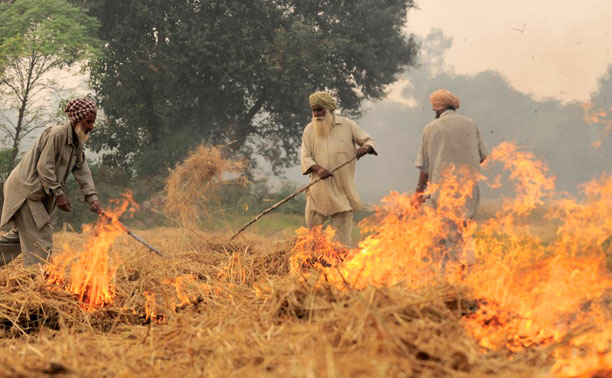
image: wikipedia
Mushroom cultivation on paddy straw creates new income, decreases air pollution
by Tim Willmott : Comments Off on Mushroom cultivation on paddy straw creates new income, decreases air pollution
Naresh Kumar of Puthar village in Haryana’s Panipat district is among the many farmers who have started farming mushrooms using paddy straw for preparing the compost needed to grow them. This has nearly ended the practice of burning crop stubble in the block.
The problem of pollution caused by burning of straws in the agricultural states of Punjab and Haryana was so severe that in 2012 the US’ National Aeronautics and Space Administration released a satellite image showing fires across millions of hectares of agricultural fields in the region. The smog and haze it caused even affected Delhi situated 100 km south.
There were local concerns as well. “The burning of straw heated land and killed soil microorganisms, harming its productivity,” says Kavita, a farmer from Puthar, adding that now farmers not only use paddy straw in mushroom farming, they also sell it to farmers in the adjoining state of Uttar Pradesh.
Indravati, a 60-year-old farmer of Israne, says the smog would cause her breathing problems. “But I have been feeling better since the past two years,” she adds.
“Israne has 17,600 hectares of paddy fields and estimates show one hectare of paddy produces 2.6 tonnes of straw,” says Rajendra Singh, agriculture officer of Israne. “Mushroom farming has ensured that Israne has stopped burning about 46,000 tonnes of paddy straw a year,” Singh calculates.
Today more than 20 marginal farmers run over 100 mushroom farms in Israne. “The total annual turnover from mushroom farming in Puthar is over Rs 2 crore,” says Rajendra Singh.
The main reason farmers were burning their field stubble was the lack of options to dispose of the straw. The easiest way was to burn it. The government had recommended that farmers should take it to the nearest biomass plant. But transporting it was costly, particularly in cases where biomass plants were not close to the village.
The problem worsened with mechanisation of agriculture. When paddy is harvested by machines, only the rice grains get plucked and long stumps of the crop are left rooted. “In our hurry to prepare the field for the rabi crop, we would just burn the straw,” says Jitendra Singh, a big landholder from Puthar. But when harvesting is done manually, the crop is hacked almost from its base, removing the need to burn the stumps.




Comments are closed